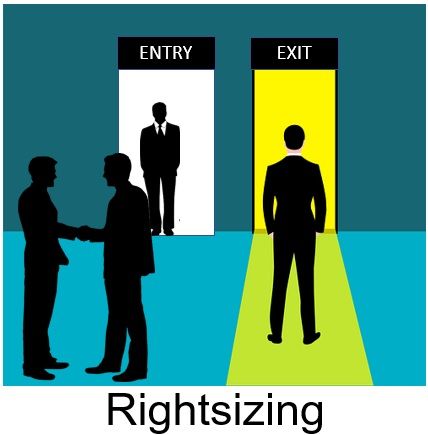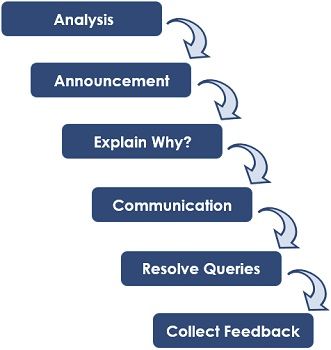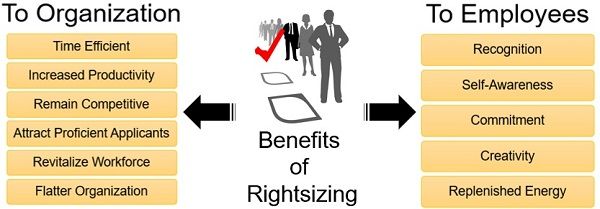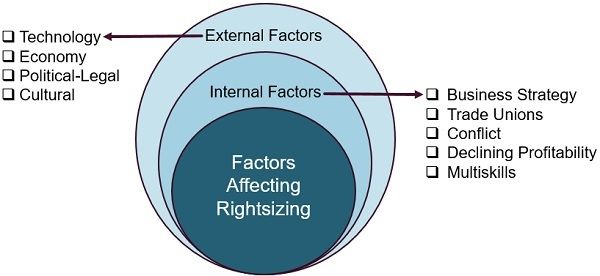Definition: Rightsizing is a strategic business tool that escalates the resources to reduce costs and remain competitive. It is a type of involuntary separation that filters the workforce in an optimum way. It is especially performed at the top level of management.
Optimization gives rise to a skilled, abled and knowledgeable workforce. Thus, organizations can achieve new and existing business goals efficiently.
It minimizes the operating cost and escalates the resources with negligible negative impact. Also, it reduces the duplication of work at the time of assessment.

In a dynamic economy, organizations estimate the over and understaffing of the workforce. For this purpose, they assess the usage of prevailing resources and their rearrangement.
Before rightsizing, you must answer the following two questions:
What do you have?
What do you need?
Some standard practices commonly used to perform rightsizing are:
- Sabbaticals
- Telework
- Part-Time Work
- Pay Cuts
- Reduced Work Weeks
- Stop Hiring
- Early Retirement
Content: Rightsizing
- Methods
- Process
- Benefits
- Limitations
- Factors Affecting Rightsizing
- Difference between Rightsizing and Downsizing
- Example
- Final Words
Methods of Rightsizing
The managers may use the following methods to Rightsize the organization:

It depicts the relationship between certain variables. The organizations perform ratio analysis to ascertain the utilization of their resources. Based on these ratios, they plan the restructuring if required. Some of the ratios one may use for this purpose are:
- Personnel to Yield Ratio
- Productivity Ratio
- Turnover Ratio
- Cost Per Hire Ratio, etc.
Activity Analysis
It analyses the personnel’s efficiency and effectiveness in performing the job assigned. For this purpose, organizations may conduct a survey based on the following determinants:
- Speed
- Duration
- Mental Activity, etc.
Process of Rightsizing
Organizations can follow some steps for performing rightsizing, which are as follows:

- Analysis of Current Structure
At first, firms conduct an in-depth analysis of their current organizational structure. After that, they try to find out whether their resources are correctly occupied or not. - Announcement
The management should make the announcement as soon as possible. So, the employees get prepared and remain cooperative during the entire process. - Explain – Why Rightsizing?
The organization should provide a valid reason to its employees for adopting Rightsizing. - Communication
The management must communicate changes to the employees affected by the process. They must also provide assistance to digest the change. - Resolve Queries
The employees may have a lot of queries at the time of restructuring. Their queries should be timely resolved to reduce confusion. - Collect Feedback
The organization should conduct 360-degree feedback to check the application of the strategy.
Benefits of Rightsizing
The process of Rightsizing benefits organizations and individuals in several ways. Distinct benefits from their perspective are given below:

To Organization
- Time Efficient
The process of Rightsizing involves less time in comparison to Downsizing. - Increased Productivity
The restructuring of organizational structure results in an overall increment in productivity. - Remain Competitive
Continuous strategic updation according to the changing environment helps to remain competitive. - Attract Proficient Applicants
The profitability and growth achieved through rightsizing attract top talent to work with the organization. - Revitalize Workforce
It is a substantial organizational change that fills new energy among the employees. - Flatter or Thinner Organization
By reducing the excessive workforce, the organizational structure becomes flatter.
To Employees
- Recognition
During the process, some employees get credit for their efforts towards the organization. - Self-Awareness
The employees become aware of their capabilities when management assigns more responsibilities to them. - Commitment
Retained employees renew their commitment towards work and organization. - Creativity
Job rotation within the organization helps to increase the creativity of the individual. - Replenished Energy
The retained and new employees refill the organization with new ideas and energy.
Limitations
- Employees get insecure about their job.
- Productive employees may leave voluntarily.
- Employees may not cooperate during the process.
- It results in decreased morale in the workforce.
- Some additional costs like hiring, training, retirement etc., are associated with it.
- It may hamper the mental and physical health of the employees.
- New talent may not approach the firm because of the termination.
- It may degrade the organization’s brand image in the industry.
Factors Affecting Rightsizing
Some internal and external factors ignite the need for Rightsizing. These factors are explained in detail below:

Internal factors include:
- Business Strategy: The change in business strategy, like expansion/contraction, leads to rightsizing. It is applied to maintain its operating efficiency.
- Trade Unions: Sometimes, unions formed create unnecessary chaos within the organization.
- Conflict: The conflict between stakeholders hampers productivity and growth. Through rightsizing, management inspects the reason and takes corrective measures.
- Declining Profitability: Firms opt to rightsize when they notice the continuous decline in their productivity.
- Multiskills: Employees with multiskills are most likely to be retained by the management. It helps in cutting costs and reducing duplicacy.
External factors include:
- Technology: Organizations need to change their resources to cope with technological advancements.
- Economy: Economic factors like interest rate, demand, supply, etc., may generate the need for rightsizing.
- Political-Legal: Companies may rightsize according to the political announcements and changes in company law, labour law, etc.
- Cultural: Cultural factors like beliefs, creativity, fashion, etc., also influence organizations. Managers may develop strategies based on these factors.
Difference between Rightsizing and Downsizing
Rightsizing is often used synonymously with Downsizing. These two are part of involuntary separation but differ from each other in certain aspects.
| Basis | Rightsizing | Downsizing |
|---|---|---|
| Meaning | Rightsizing is restructuring or reorganizing a business to cut costs | Downsizing is a reduction in the workforce through layoffs |
| Size of Organization | Adjusting the size of the workforce to reach the exact size required to operate | Reduces the size of the organization as a whole |
| Motive | The goal is to maximize the profit | The goal is to flatten the size of the organization |
| Type of Process | It is a positive process | It is a negative process |
| Acquiring fresh talent | The organization may acquire fresh talent if required | The organization do not acquire fresh talent during the process |
| Example | Job Rotation, Interdepartmental Transfers, Infrastructure Automation, etc. | Merger, Acquisitions, etc. |
Example
Anglo American Platinum is a huge producer of platinum in the world. The company restructured itself by laying off 6000 workers in South Africa.
This restructuring will help them return to their profitability. The company can focus their capital allocation on mines at the best places. It will sustain their business and create employment opportunities in the long run.
Addisu Admassu says
Thank you so much that was so helpful. It has given me an insight about the topic in a short and precise way.